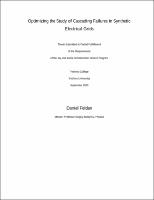Please use this identifier to cite or link to this item:
https://hdl.handle.net/20.500.12202/6201| Title: | Maximizing the Study of Cascading Failures in Synthetic Electrical Grids. |
| Authors: | Buldyrev, Sergey Feldan, Daniel |
| Keywords: | power grids Senior honors thesis |
| Issue Date: | Sep-2020 |
| Publisher: | New York, NY: Yeshiva College. Yeshiva University. |
| Citation: | Feldan, Daniel. (September 2020). Maximizing the Study of Cascading Failures in Synthetic Electrical Grids Thesis Submitted in Partial Fulfillment of the Requirements of the Jay and Jeanie Schottenstein Honors Program. Yeshiva College, Yeshiva University. September 2020. Mentor: Professor Sergey Buldyrev, Physics. |
| Abstract: | Power grids can be modeled as a network of nodes and the electrical lines that connect them. Removal of a single node or a group of nodes, either by natural systemic failure or human attack, causes a redistribution of power in the network which can overload any number of nodes1,2,3,4. When these nodes overload, they fail and cause a further redistribution of power within the network. This process can repeat and lead to massive cascading failures in the network, causing major blackouts or a complete failure of the network2,3. However, while these blackouts can be devastating, it is found that during the initial stages of a cascading failure that leads to a blackout there is a latent period where the damage is mostly localized and the decrease in yield of the system (the fraction of demand satisfied after the cascade) is insignificant1. This is important because if a real-world cascading failure begins in a network, a fast simulation of the same failure can be executed during this latent period and be used to help prevent major losses in the network’s yield. The goal of this project is to produce accurate and rapid simulations of cascading failures in order to study how they behave and the properties of the electrical networks that cause them.... Many people studying failures in power grids use a direct current power flow model1,3. For the purposes of our research we will be utilizing a similar DC power flow model which is equivalent to the flows in a resistor network1,3. This allows us to utilize Kirchhoff’s Equations to solve the flow of the network at any point during a failure..., However, in actuality it is very difficult to study the properties of electrical networks and the cascading failures that occur within them because there is very little publicly available data on electrical networks6,7,8. This is due to the fact that by releasing the structure of an electrical grid, the vulnerabilities of the grid would also be revealed6,7,8. Therefore, this project will focus not on real world data, but will utilize a data set produced by researchers at Columbia University that resembles a synthetic electrical grid6,7,8,9...... The rest of the paper is organized as follows. In Section II we describe the synthetic power grid and perform some simple data exploration on the grid itself. Then in Section III we will discuss our initial goals and methods for creating fast simulations of cascading failures in the power grid. Finally, in Section IV we will discuss and summarize our results. |
| Description: | Senior honors thesis. Open Access. Includes software code. |
| URI: | https://hdl.handle.net/20.500.12202/6201 |
| Appears in Collections: | Jay and Jeanie Schottenstein Honors Student Theses |
Files in This Item:
| File | Description | Size | Format | |
|---|---|---|---|---|
| Processing_Code.tar.gz | 5.3 MB | GZIP file | View/Open | |
| Feldan OA Revised 1Oct2020 Optimizing the Study of Cascading Failures in Synthetic Electrical Grids.pdf | 277.41 kB | Adobe PDF |  View/Open |
This item is licensed under a Creative Commons License

